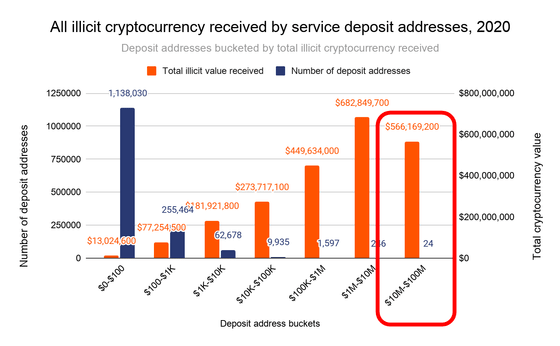More than half of money laundering on crypto assets turns out to be due to only 270 addresses

'55% of crypto assets used in fraud-related transactions are sent to just 270 addresses,' said Chainalysis, a research firm that tracks crypto asset fraud. This highlights the fact that money laundering by cybercriminals is concentrated in a very small number of channels, Chainalysis points out.
Chainalysis Blog | 270 Service Deposit Addresses Drive 55% of Money Laundering in Cryptocurrency
On January 19, 2021, Chainalysis released a large-scale research document that provided an overview of cryptocurrency-related crimes committed in 2020. According to this report, crimes related to crypto assets are shrinking as a whole, but crypto assets are still misused for crimes, such as 'Cybercriminals earned at least 36.7 billion yen in 2020.' It turns out that there is a current situation.
Cyber criminals reported to have earned at least 36.7 billion yen in crypto assets in 2020 alone-GIGAZINE

In addition, Chainalysis updated its official blog on February 11, 2021 to report that 'cryptocurrency gained through fraudulent activity is being money laundered through a very limited route.'
The following is a color-coded map of the destinations of crypto assets sent from fraudulent addresses according to size, and the darker the color, the larger the amount of crypto assets being remitted. 'The United States, Russia, China, South Africa, the United Kingdom, Ukraine, South Korea, Vietnam, Turkey, and France were the countries with the highest receipts of cryptocurrencies from fraudulent addresses,' said Chainalysis.

We also know that the addresses themselves that receive fraudulent crypto assets are also heavily biased. Below is a graph showing the relationship between the amount of fraudulently traded crypto assets (orange bar graph) and the number of addresses that received them (blue bar graph) by scale. For example, if you look at the part surrounded by the red frame, you can see that there are 1,138,030 addresses that illegally receive cryptocurrency assets of 100 dollars (about 10,550 yen) or less.

On the other hand, 24 addresses received more than 10 million dollars (1,054,960,000 yen), and as the amount of illegally remitted cryptocurrency assets increased, so did the addresses that received them.

According to the findings, Chainalysis said, 'Money laundering through crypto assets is concentrated on specific addresses. From data, only 75% of crypto assets sent from fraudulent addresses during 2020 will be. It turns out that 1867 addresses have been received. In addition, 55% of the total was sent to the top 270 addresses. The fraudulent cryptocurrencies received by these 270 addresses in 2020. The assets amounted to 1.3 billion dollars (137,173.4 million yen), of which 500 million dollars (about 52,759 million yen) were sent to only 24 addresses. '
At the end of the article, Chainalysis concluded that it is imperative that experts and investigators keep an eye on all remittance destinations to prevent crypto assets from being misused for money laundering.
Related Posts:
in Note, Posted by log1l_ks






